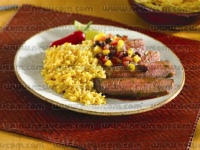Lawry’s and B. Smith Celebrate Caribbean-American Heritage Month with delicious new recipes
CHICAGO – Seismic sounds, fiery flavors, an array of vibrant colors, exotic fruits and vegetables — these trademarks of Caribbean culture are as diverse as the islands that make up the Caribbean. From Jamaica and Haiti to Cuba and Puerto Rico, the Caribbean culture is a fusion of high energy, colorful music, customs, and foods.
In acknowledgement of this rich culture, Lawry’s yearlong Cooking Up Culture program proudly celebrates the influence of Caribbean cuisine on American dishes, and just in time to celebrate the 2nd annual Caribbean-American Heritage Month in the U.S.

Enjoy Caribbean cooking at home with this Chile Lime Steak with Black Bean and Mango Salsa dish. Lawry’s makes it simple to prepare in your own kitchen.
(PRNewsFoto/Unilever)
“Caribbean cuisine is one of the most flavorful and festive cuisines that we love here in America,” says Lawry’s spokesperson B. Smith. “With a melange of cultural influences from Spain, France, India and Africa, and even Mexico, Caribbean foods marry tropical flavors with delicious spices to create unique and exciting dishes.
That’s why America has been known to celebrate Caribbean cuisine, whether through take-out jerk chicken restaurants or more upscale, sit-down establishments that offer Caribbean fare. Lawry’s marinades are an easy, convenient way to bring the exotic flavors from the Caribbean to your own home-cooked meals. Try marinade flavors such as Lawry’s Caribbean Jerk, Havana Garlic & Lime or Mexican Chile & Lime to infuse the tastes of the Caribbean into your meals.”
The foods of the Caribbean are marked by a wide variety of fruits, vegetables, meats, grains, and spices, all of which contribute to the area’s unique cuisine. European colonists, including the Portuguese, Dutch, Danish, British, French and the Swedes, brought oranges, limes, mangoes,
rice and coffee to the Caribbean.
They also introduced sugarcane, which was later fermented to make rum, a drink that remains the ultimate tropical Caribbean beverage. Spaniards introduced other foods, notably coconut, chick-peas, cilantro, eggplant, onions, and garlic. West Africans introduced okra, pigeon peas, plantains, callaloo, taro, breadfruit and ackee. Mexico’s donations include papaya, avocado, chayote, and cocoa.
In addition, laborers from India and China came to work in the fields and plantations of the Caribbean, adding two very different culinary influences to the already robust melting pot of Caribbean flavors.
Since many of the Caribbean islands had wild pigs and cattle, spiced and smoked meats became an integral part of the people’s diet, the most
popular being jerk meat. Many of the foods and spices from the Caribbean’s island cooking have been exported to other continents around the world, becoming a familiar mainstay in many kitchens.
Easy-to-make, Caribbean-inspired recipes, are available at www.lawrys.com.



